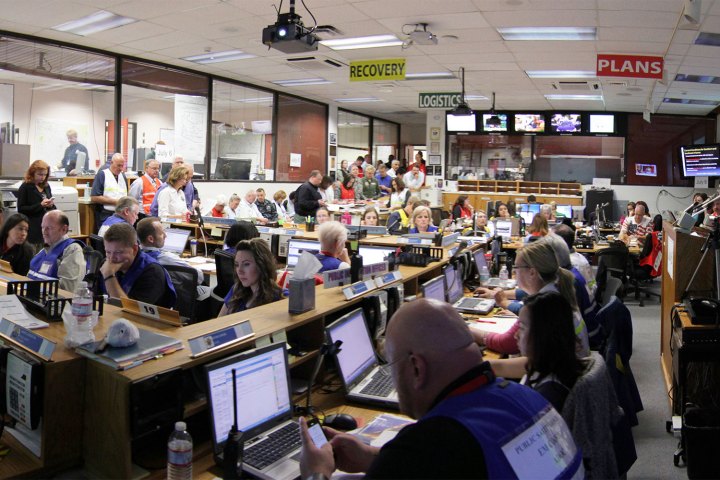
With over 32 years of experience in search and rescue operations, Jesse Robinson, the Search and Rescue Coordinator for the Arizona Department of Emergency and Military Affairs, has seen technological advancements in search and rescue that have truly saved lives.
“The most notable advancements to the search and rescue field have come in aviation observation and cell phone forensics,” Robinson said. “In SAR operations, time is our critical element. To save lives we have to beat the clock.”
Searching from the sky
In late 2013 Robinson’s office received a call for assistance to locate a missing elderly man from Henderson, Nevada. A recent fuel purchase on a credit card placed him in Arizona and a cell phone tower had pinged his phone in a rugged and remote wilderness area of central Arizona outside of Wickenburg.
In SAR operations, time is our critical element. To save lives we have to beat the clock.
A Civil Air Patrol plane equipped with an Airborne Real-time Cueing Hyperspectral Enhanced Reconnaissance system, or ARCHER, was dispatched to the area. The ARCHER system is the most sophisticated unclassified hyperspectral imaging system available and produces ground images far more detailed than plain sight or ordinary aerial photography can.
Where the human eye sees three basic bands of light, the optical sensor of the ARCHER sees fifty. The ARCHER system uses geoscience to distinguish variations in the terrain and vegetation, and with as little as 10 percent of a target visible, it can identify abnormalities to the environment.
ARCHER’s three scanning methods
Three detection methods are used by the ARCHER system during aerial reconnaissance. First, the system matches reflected light to spectral signatures such as wreckage from a downed airplane. Secondly, it uses anomaly detection to calculate a statistical model of all the pixels in the image to see if there is a probability that a pixel does not fit. Lastly, it compares change detection by conducting a pixel-by-pixel comparison of data looking for abnormalities between them.
“At the time all we had to go on was that the missing subject was driving a green Toyota 4Runner,” Robinson said.

By obtaining the paint color code for the green paint used by Toyota on the 4Runner, the search and rescue team could program the ARCHER system to identify when a match was located during the digital reconnaissance of the area, ultimately locating the missing man’s vehicle during the image analysis.
“Without the ARCHER system, a search of that magnitude and vast area would have taken days, not hours,” Robinson said. “You have to understand that during aerial searches a pilot’s attention is divided by operation of the aircraft and the co-pilot is assisting with navigation and communications. A third person may be present but their view is limited to only one side of the aircraft. The ARCHER system provides us the best opportunity to conduct thorough aerial reconnaissance and maximize our chances of finding a lost person.”
Following cell signal breadcrumbs
Cell phones have become equally important for locating missing or distressed hikers. With legislation mandating companies to include a GPS chip in all new cell phones and the increase of smartphone applications with location-based services, cell phones are increasingly becoming a factor in emergency services.
Before cell phone forensics, many SAR managers did not put a high priority on obtaining cell phone data because too much time had passed when the subject was last seen or heard from, or the subject was thought to be in a “dead zone”. While these concerns may have been accurate, important information such as probability of area can be derived before the phone went dead.
A trained technician can translate the data provided by the cell towers into a three-dimensional picture.
Even when a cell phone is not in its carrier’s coverage area or signal is too weak to make a call or send a text, it still “pings” towers in the area. A ping is when the tower and phone make a brief connection registering a digital exchange between the two.
In many wilderness searches, there may be only one tower involved due to the remote location of the search area. A brief ping can provide information as to when the phone was last in the area. The signal strength of the ping will also provide a maximum distance that the cell phone was from the tower for the ping to have registered.
When multiple towers are able to ping a cell phone, a trained cell phone forensics technician can use this information to establish a search area. By analyzing the signal strength from each of the towers, and topographic imagery, a generalized search area can be estimated by the technician.
“A trained technician can translate the data provided by the cell towers into a three-dimensional picture of where the phone had to be in proximity to the tower and at what elevation it would had to have been to reach the tower’s location,” Robinson said. “With data from multiple towers we can project direction of travel, speed, and focus our search efforts in that area.”
Robinson explained that in the last five years his office has not only seen a decline in search requests but an increase in successful rescues. With these technological advancements, a potentially dire situation can be lessened to more of an inconvenience.


